Spatio-Temporal Coupling Coordination and Driving Mechanism of Urban Pseudo and Reality Human Settlements in the Coastal Cities of China
Abstract
1. Introduction
2. Theoretical Framework
2.1. Constituent Elements
2.2. Technology Roadmap
3. Overview of the Study Area and Data Sources
3.1. Study Area
3.2. Model Construction and Data Sources
4. Research Methods
4.1. Coupling Coordination Degree Model
4.2. Geo-Detector Model
4.3. Center of Gravity and Standard Deviation Ellipse Models
- The CoG: The CoG indicates the position of the spatial center of the CCD and its variations, providing insights into whether the CCD is experiencing a trend of centralization or spatial migration. The corresponding calculation formula is presented below:
- 2.
- The SDE: The SDE reveals the spatial expansion and main direction of CCD by depicting the distribution range and directionality of CCD.
5. Results
5.1. Time Course of CCD
5.2. Spatial Pattern of CCD
5.3. Analysis of the Evolution of Spatial Patterns of CCD
5.3.1. Center of Gravity Migration Analysis
5.3.2. Standard Deviation Elliptic Analysis
5.4. Driving Mechanisms of CCD
5.4.1. Factor Analysis
5.4.2. System Analysis
5.4.3. Morphological Analysis
5.4.4. Exploration of Mechanisms
- Socio-economic development drives the CCD. China’s economic growth fosters investments in urban infrastructure, education, healthcare, culture, social security, and environmental improvement. Economic factors are vital in the spatial and temporal development of CCD, as evidenced in cities such as Guangzhou and Shanghai, where increased economic growth improves CCD.
- Human beings are the primary driver of CCD between the PHS and RHS, with all systems ultimately aimed at fulfilling their developmental and value needs. Urban planners must prioritize human-centered city development, focusing on key aspects such as living, working, transportation, education, and healthcare. Population growth and quality improvements drive human system advancements, positively impacting CCD. To enhance residents’ quality of life, planners should optimize urban settlements by addressing their transportation, education, and healthcare needs.
- The growing importance of network big data in the CCD is evident, with its influence continuing to expand as information technology becomes more widely integrated into public life. PHS are rooted in the development of big data on the web, which has led to the transformation and expansion of PHS and RHS, and nowadays, the web has become an important platform for people to get information, communicate, shop, and entertain themselves. The onset of the information age has broadened the behavioral dynamics within cities, increased the flow of elements across different urban systems, and promoted the advancement of PHS. This has resulted in a rise in activities like online shopping, social interactions, and recreation, which are becoming more common.
6. Discussion
6.1. Research on the Sustainable Development of RHS and PHS
6.2. Limitations and Future Directions
- Diversification of data sources. The data in this paper mainly consists of mimetic data such as information searches and online social interactions, as well as real data such as social and economic data. It does not take into account urban residents’ acceptance of PHS and their level of awareness of its ecological benefits, and fails to comprehensively consider the needs and wishes of urban residents. In the future, we will introduce image data to analyze the real factors that affect the temporal and spatial evolution of PHS.
- Comprehensive research content. This paper mainly focuses on PHS and RHS as research objects, but the human settlement environment is a complex giant system, and PHS and RHS are only part of the human settlement environment system. Studying only PHS and RHS cannot reasonably explain the complex relationship between humans and the environment. In future research, we will conduct more comprehensive research on the coupling and coordination of the human settlement environment, such as the imaginary human settlement environment, to promote the comprehensive development of human settlement geography.
- Deepening the content of the research. This paper mainly conducts preliminary research on the spatiotemporal characteristics and driving factors of the coupling and coordination of PHS, but does not yet analyze the driving mechanisms of the research results in depth. In future research, we will explore in depth the complex interactive relationships between different elements and systems, as well as how these interactions drive the results.
6.3. Policy Recommendations
- Insist on giving equal weight to both PHS and RHS. There are differences between the current state of PHS and RHS development in 53 coastal cities in China. In the early stages of urbanization, the northeast region focused more on realistic factors such as economic development, population, science, education, culture, and health. With the advent of the information age, big data has gradually entered into urban production, life, and management, and the long-term neglect of PHS has hindered the coordinated development of urban systems. In the future, more attention should be paid to the construction of PHS systems to improve PHS.
- Adhere to local conditions and coordinated development, and follow the differences in the quality of the human habitat in various places. There is a lack of unified planning in the construction of the urban human habitat, and there are differences and inconsistencies between regions. In areas with low levels of coordinated development, such as Fangchenggang and Beihai, policy support should be increased to improve the livability and business friendliness of the region. In cities with high levels of coordination, such as Shanghai and Guangzhou, their radiating and driving role should continue to be played, realizing the leading role of the core and the coordinated development of the core and peripheral areas. The construction of urban PHS needs to take into account the needs and characteristics of the RHS, effectively solve practical problems, and gradually promote the construction of urban PHS.
- Adhere to refined management. Adhere to refined management and continuously build and improve public infrastructure, such as barrier-free access, blind paths, and mother and baby rooms, to meet the livability needs of special groups and improve people’s livelihood security and happiness. The construction of PHS needs to be based on RHS and achieve coordinated development through the establishment of connections.
7. Conclusions
- (1)
- Temporal process: During the study period, the overall CCD of the human settlement (HS) system in coastal cities exhibited a pattern of initial increase followed by a decline, indicating notable temporal variability. The upward trend in the earlier phase can be attributed to rapid economic growth and accelerated urbanization, which contributed to comprehensive improvements in various aspects of HS. However, the subsequent decline may reflect growing constraints such as resource and environmental pressures, imbalanced regional development, and adjustments in national policy.
- (2)
- Spatial pattern: The coordination status of human settlements in China’s coastal zone demonstrates a relatively dispersed spatial distribution, with no consolidated high-coordination region emerging. Southern coastal cities generally outperform their northern counterparts in terms of CCD, which may be associated with more advanced economic development, ecological conservation efforts, and governance capacity in the south. These findings suggest a need for targeted policy interventions to enhance coordination levels in northern regions.
- (3)
- Spatial evolution: The coordination between RHS and PHS subsystems shows a discernible southwestward shift, with cities in the southwestern region experiencing more rapid growth in CCD. This trend reflects a reduction in the spatial concentration of coupling coordination and a narrowing of developmental disparities among coastal cities. Supportive national policies, particularly those emphasized in the 19th and 20th National Congresses of the Communist Party of China advocating regional coordinated development, have facilitated improvement in western and southern coastal areas, contributing to greater regional equilibrium.
- (4)
- Driving factors: Socioeconomic development level constitutes the most critical factor influencing the coordination between PHS and RHS. Regions with higher economic development tend to exhibit superior performance in infrastructure, public services, and ecological protection, which in turn facilitates positive interaction and synergistic development between the two systems. Moreover, the role of residents—the core agents of urban development—cannot be overlooked. All institutional arrangements ultimately aim to serve human needs and enhance quality of life, underscoring the importance of human-centered approaches in promoting HS coordination.
Author Contributions
Funding
Data Availability Statement
Conflicts of Interest
References
- Hong, S.; Hyoung Kim, S.; Kim, Y.; Park, J. Big Data and government: Evidence of the role of Big Data for smart cities. Big Data Soc. 2019, 6, 2053951719842543. [Google Scholar] [CrossRef]
- Cheng, C.; Shi, P.; Song, C.; Gao, J. Geographical Big Data: A New Opportunity for Geography Complexity Study. Acta Geogr. Sin. 2018, 73, 1397–1406. [Google Scholar] [CrossRef]
- Gu, C. A Masterpiece on the Study of Human Settlements’ Mimetic Environment: A Review of Geographical Research on Human Settlements: From Positivism to Humanism. Geogr. Res. 2015, 34, 1604. [Google Scholar]
- Pinto, M.R.; Salume, P.K.; Barbosa, M.W.; de Sousa, P.R. The path to digital maturity: A cluster analysis of the retail industry in an emerging economy. Technol. Soc. 2022, 72, 102191. [Google Scholar] [CrossRef]
- Tian, S.; Li, X.; Yang, J.; Wang, H.; Guo, J. Spatiotemporal evolution of pseudo human settlements: Case study of 36 cities in the three provinces of Northeast China from 2011 to 2018. Environ. Dev. Sustain. 2022, 25, 1742–1772. [Google Scholar] [CrossRef]
- Xue, Q.; Yang, X.; Wu, F. A two-stage system analysis of real and pseudo urban human settlements in China. J. Clean. Prod. 2021, 293, 126272. [Google Scholar] [CrossRef]
- LazauskaitĖ, D.; BurinskienĖ, M.; Podvezko, V. Subjectively and objectively integrated assessment of the quality indices of the suburban residential environment. Int. J. Strateg. Prop. Manag. 2015, 19, 297–308. [Google Scholar] [CrossRef]
- Ni, F.; Wang, Q.; Shao, W.; Zhang, J.; Shan, Y.; Sun, X.; Guan, Q. Spatiotemporal characteristics and driving mechanisms of PM10 in arid and semi-arid cities of northwest China. J. Clean. Prod. 2023, 419, 138273. [Google Scholar] [CrossRef]
- Zhao, H.; Gu, T.; Sun, D.; Miao, C. Dynamic evolution and mechanism of urban human settlements in the Yellow River Basin from the perspective of production-living-ecological space. Acta Geogr. Sin. 2023, 78, 2973–2999. [Google Scholar] [CrossRef]
- Fan, J.; Zhao, P.; Zhou, S.; Deng, X.; Wang, C. Discipline system and development strategy of human geography in China. Acta Geogr. Sin. 2021, 76, 2083–2093. [Google Scholar] [CrossRef]
- Chen, F.; Wu, S.; Liu, H.; Yang, X.; Liu, J. Discipline system and development strategy of physical geography in China. Acta Geogr. Sin. 2021, 76, 2074–2082. [Google Scholar] [CrossRef]
- Li, J.; Li, G.; Liang, Y.; Yuan, J.; Xu, G.; Yang, C. Spatiotemporal differentiation of the ecosystem service value and its coupling relationship with urbanization: A case study of the Lanzhou-Xining urban agglomeration. Ecol. Indic. 2024, 160, 111932. [Google Scholar] [CrossRef]
- Huang, Z.; Chen, Y.; Zheng, Z.; Wu, Z. Spatiotemporal coupling analysis between human footprint and ecosystem service value in the highly urbanized Pearl River Delta urban Agglomeration, China. Ecol. Indic. 2023, 148, 110033. [Google Scholar] [CrossRef]
- Song, F.; Yang, X.; Wu, F. Suitable Pattern of the Natural Environment of Human Settlements in the Lower Reaches of the Yangtze River. Atmosphere 2019, 10, 200. [Google Scholar] [CrossRef]
- Dou, H.; Ma, L.; Li, H.; Bo, J.; Fang, F. Impact evaluation and driving type identification of human factors on rural human settlement environment: Taking Gansu Province, China as an example. Open Geosci. 2020, 12, 1324–1337. [Google Scholar] [CrossRef]
- Xiong, J.; Wang, X.; Zhao, D.; Zhao, Y. Spatiotemporal pattern and driving forces of ecological carrying capacity during urbanization process in the Dongting Lake area, China. Ecol. Indic. 2022, 144, 109486. [Google Scholar] [CrossRef]
- Wang, X.; Wang, J.; Wang, B.; Burkhard, B.; Che, L.; Dai, C.; Zheng, L. The Nature-Based Ecological Engineering Paradigm: Symbiosis, Coupling, and Coordination. Engineering 2022, 19, 14–21. [Google Scholar] [CrossRef]
- Doxiadis, C.A. Ekistics, the Science of Human Settlements: Ekistics starts with the premise that human settlements are susceptible of systematic investigation. Science 1970, 170, 393–404. [Google Scholar] [CrossRef] [PubMed]
- Li, H.; Lou, L.; Wang, Y.; Tian, S.; Yang, J.; Cong, X. Spatio-temporal dynamic evolution characteristics and driving mechanism analysis of urban pseudo human settlements. Front. Earth Sci. 2024, 12, 1454572. [Google Scholar] [CrossRef]
- Tian, S.; Yang, B.; Liu, Z.; Li, X.; Zhang, W. Coupling Coordination of Urban Pseudo and Reality Human Settlements. Land 2022, 11, 414. [Google Scholar] [CrossRef]
- Ye, C.; Pi, J.; Chen, H. Coupling Coordination Development of the Logistics Industry, New Urbanization and the Ecological Environment in the Yangtze River Economic Belt. Sustainability 2022, 14, 5298. [Google Scholar] [CrossRef]
- Lin, T.; Zhang, L.; Li, J. Coupling and coordinated development of green finance and renewable energy industry in China: Spatiotemporal differentiation and driving factors. Renew. Energy 2024, 235, 121255. [Google Scholar] [CrossRef]
- Liu, J.; Tian, Y.; Huang, K.; Yi, T. Spatial-temporal differentiation of the coupling coordinated development of regional energy-economy-ecology system: A case study of the Yangtze River Economic Belt. Ecol. Indic. 2021, 124, 107394. [Google Scholar] [CrossRef]
- Yang, S.; Yan, H.; Gong, Y.; Zeng, S. Coupling coordination of the provision of medical services and high-quality economic development in the Yangtze River Economic Belt. Front. Public Health 2024, 11, 1298875. [Google Scholar] [CrossRef] [PubMed]
- Yu, T.; Zhang, Y.; Jia, S.; Cui, X. Spatio-temporal evolution and drivers of coupling coordination between digital infrastructure and inclusive green growth: Evidence from the Yangtze River economic belt. J. Environ. Manag. 2025, 376, 124416. [Google Scholar] [CrossRef]
- Zhang, Y.; Khan, S.U.; Swallow, B.; Liu, W.; Zhao, M. Coupling coordination analysis of China’s water resources utilization efficiency and economic development level. J. Clean. Prod. 2022, 373, 133874. [Google Scholar] [CrossRef]
- Han, X.; Fu, L.; Lv, C.; Peng, J. Measurement and spatio-temporal heterogeneity analysis of the coupling coordinated development among the digital economy, technological innovation and ecological environment. Ecol. Indic. 2023, 151, 110325. [Google Scholar] [CrossRef]
- Chen, D.; Zhong, L.; Fan, J.; Yu, H.; Yang, D.; Zeng, Y. Evaluation and structural analysis of the functions of the Tibetan Plateau National Park Cluster. J. Geogr. Sci. 2022, 32, 957–980. [Google Scholar] [CrossRef]
- Shi, Y.; Feng, C.-C.; Yu, Q.; Han, R.; Guo, L. Contradiction or coordination? The spatiotemporal relationship between landscape ecological risks and urbanization from coupling perspectives in China. J. Clean. Prod. 2022, 363, 132557. [Google Scholar] [CrossRef]
- Li, S.; Du, S. An Empirical Study on the Coupling Coordination Relationship between Cultural Tourism Industry Competitiveness and Tourism Flow. Sustainability 2021, 13, 5525. [Google Scholar] [CrossRef]
- Yu, Z.; Liu, W.; Ren, Q.; Zhong, J. Analysis of the coordinated evolution and driving mechanism of the coupling of tourism economy and urbanization in Southwest China. Curr. Issues Tour. 2024, 28, 891–909. [Google Scholar] [CrossRef]
- Wang, M.; Wang, X. A study of eco-culture-tourism coupling and coordinated development and influencing mechanism in the Yellow River Basin based on spatial production theory. Ecol. Indic. 2025, 176, 113689. [Google Scholar] [CrossRef]
- Tian, S.; Wang, Y.; Li, X.; Wu, W.; Yang, J.; Cong, X.; Wang, H. Spatio-Temporal Evolution and Driving Mechanism of Coupling Coordination of Pseudo Human Settlements in Central China’s Urban Agglomerations. Land 2024, 13, 858. [Google Scholar] [CrossRef]
- Chu, N.; Zhang, P.; Wu, X. Spatiotemporal evolution characteristics of urbanization and its coupling coordination degree in Russia—Perspectives from the population, economy, society, and eco-environment. Environ. Sci. Pollut. Res. 2022, 29, 61334–61351. [Google Scholar] [CrossRef] [PubMed]
- Zhang, D.; Chen, Y. Evaluation on urban environmental sustainability and coupling coordination among its dimensions: A case study of Shandong Province, China. Sustain. Cities Soc. 2021, 75, 103351. [Google Scholar] [CrossRef]
- Zhang, J.; Yuan, J.; Wang, Y. Spatio-temporal evolution and influencing factors of coupling coordination between urban resilience and high-quality development in Yangtze River Delta Area, China. Front. Environ. Sci. 2023, 11, 1174875. [Google Scholar] [CrossRef]
- Eggert, A.L.; Löwe, R.; Arnbjerg-Nielsen, K. Feedbacks between city development and coastal adaptation: A systems thinking approach. Ocean Coast. Manag. 2024, 249, 107026. [Google Scholar] [CrossRef]
- Zeng, S.; Zhou, G.; Xiao, G.; Peng, J. Review on Domestic Rural Settlements Research from Geography Perspective. Hum. Geogr. 2011, 26, 68–73. [Google Scholar] [CrossRef]
- Bolton, R.N.; McColl-Kennedy, J.R.; Cheung, L.; Gallan, A.; Orsingher, C.; Witell, L.; Zaki, M. Customer experience challenges: Bringing together digital, physical and social realms. J. Serv. Manag. 2018, 29, 776–808. [Google Scholar] [CrossRef]
- Matt, G. Climatic change and climatic variability: An objective decomposition. Quat. Sci. Rev. 2021, 271, 107196. [Google Scholar] [CrossRef]
- Tian, S.; Li, X.; Yang, J.; Zhang, W.; Guo, J. Spatio-temporal coupling characteristics and mechanism of urban mimetic and real human settlements in Northeast China. Acta Geogr. Sin. 2021, 76, 781–798. [Google Scholar] [CrossRef]
- Sun, Y.; Hou, G.; Huang, Z.; Zhong, Y. Spatial-Temporal Differences and Influencing Factors of Tourism Eco-Efficiency in China’s Three Major Urban Agglomerations Based on the Super-EBM Model. Sustainability 2020, 12, 4156. [Google Scholar] [CrossRef]
- Yang, C.; Zeng, W.; Yang, X. Coupling coordination evaluation and sustainable development pattern of geo-ecological environment and urbanization in Chongqing municipality, China. Sustain. Cities Soc. 2020, 61, 102271. [Google Scholar] [CrossRef]
- Liu, H.; Li, X.; Tian, S.; Guan, Y. Research on the Evaluation of Resilience and Influencing Factors of the Urban Network Structure in the Three Provinces of Northeast China Based on Multiple Flows. Buildings 2022, 12, 945. [Google Scholar] [CrossRef]
- Cheng, Z.; Zhang, Y.; Wang, L.; Wei, L.; Wu, X. An Analysis of Land-Use Conflict Potential Based on the Perspective of Production–Living–Ecological Function. Sustainability 2022, 14, 5936. [Google Scholar] [CrossRef]
- Chen, C.; Zhang, W.; Zhan, D.; Li, X. Assessment of urban human settlement quality and its influencing factors in the Bohai Rim area. Prog. Geogr. 2017, 36, 1562–1570. [Google Scholar] [CrossRef]
- Wu, L. Introduction to Sciences of Human Settlements; China Architecture & Building Press: Beijing, China, 2001; pp. 40–48, 222–228. [Google Scholar]
- Szczepańska, A.; Kaźmierczak, R.; Myszkowska, M. Virtual Reality as a Tool for Public Consultations in Spatial Planning and Management. Energies 2021, 14, 6046. [Google Scholar] [CrossRef]
- Li, B.; Qu, Y. The influence of industrial path dependence and breakthrough on regional economic resilience in China’s coastal areas. Acta Geogr. Sin. 2023, 78, 824–839. [Google Scholar] [CrossRef]
- Central Committee of the Communist Party of China, State Council. Outline of the Yangtze River Delta Regional Integrated Development Plan; Central Committee of the Communist Party of China, State Council: Beijing, China, 2019. [Google Scholar]
- Dong, F.; Li, W. Research on the coupling coordination degree of “upstream-midstream-downstream” of China’s wind power industry chain. J. Clean. Prod. 2020, 283, 124633. [Google Scholar] [CrossRef]
- Cong, X. The Form, Nature and Several Misuses of Coupling Degree Model in Geography. Econ. Geogr. 2019, 39, 18–25. [Google Scholar] [CrossRef]
- Zou, C.; Zhu, J.; Lou, K.; Yang, L. Coupling coordination and spatiotemporal heterogeneity between urbanization and ecological environment in Shaanxi Province, China. Ecol. Indic. 2022, 141, 109152. [Google Scholar] [CrossRef]
- Wang, J.F.; Li, X.H.; Christakos, G.; Liao, Y.L.; Zhang, T.; Gu, X.; Zheng, X.Y. Geographical Detectors--Based Health Risk Assessment and its Application in the Neural Tube Defects Study of the Heshun Region, China. Int. J. Geogr. Inf. Sci. 2010, 24, 107–127. [Google Scholar] [CrossRef]
- Azuz-Adeath, I.; Yañez-Arancibia, A. Climate Change: Ecological and socio economic dimensions in the coastal zone. Ecol. Eng. 2019, 130, 228–232. [Google Scholar] [CrossRef]
- Wang, Y.; Geng, Q.; Si, X.; Kan, L. Coupling and coordination analysis of urbanization, economy and environment of Shandong Province, China. Environ. Dev. Sustain. 2020, 23, 10397–10415. [Google Scholar] [CrossRef]
- Zhao, Y.; Wu, Q.; Wei, P.; Zhao, H.; Zhang, X.; Pang, C. Explore the Mitigation Mechanism of Urban Thermal Environment by Integrating Geographic Detector and Standard Deviation Ellipse (SDE). Remote Sens. 2022, 14, 3411. [Google Scholar] [CrossRef]
- Wang, Z.; Wang, Y.; Zhao, L.; Zhao, L. Spatio-temporal evolution and influencing factors of total factor productivity in China’s manufacturing industry. Acta Geogr. Sin. 2021, 76, 3061–3075. [Google Scholar] [CrossRef]
- Sun, J.; Jiang, Z. The path of high-quality development of China’s coastal areas. Acta Geogr. Sin. 2021, 76, 277–294. [Google Scholar] [CrossRef]
- Kong, Y.; Zhen, F.; Zhang, S. Research progress and thinking on urban space under the influence of intelligent technology. Prog. Geogr. 2022, 41, 1068–1081. [Google Scholar] [CrossRef]
- Kong, Y.; Zhen, F.; Zhang, S. Research Progress and Prospect of the Impact of Intelligent Technology on Urban Residents’ Activities. Sci. Geogr. Sin. 2022, 42, 413–425. [Google Scholar]
- Fang, K.; He, J.; Zhang, J. Substantiating the Botai Line as China’s Regional Development Equilibrium Boundary: A Case Study of Urban Greenhouse Gas Emissions. Acta Geogr. Sin. 2021, 76, 3090–3102. [Google Scholar] [CrossRef]
- Deng, X.; Liang, L.; Wu, F.; Wang, Z.; He, S. Regional Balanced Development in China from the Perspective of Development Geography. Acta Geogr. Sin. 2021, 76, 261–276. [Google Scholar] [CrossRef]
- Dayaratne, R. Creating places through participatory design: Psychological techniques to understand people’s conceptions. J. Hous. Built Environ. 2016, 31, 719–741. [Google Scholar] [CrossRef]
- Long, Y. (New) Urban science: Studying “new” cities with new data, methods, and technologies. Landsc. Archit. Front. 2019, 7, 8–21. [Google Scholar] [CrossRef]
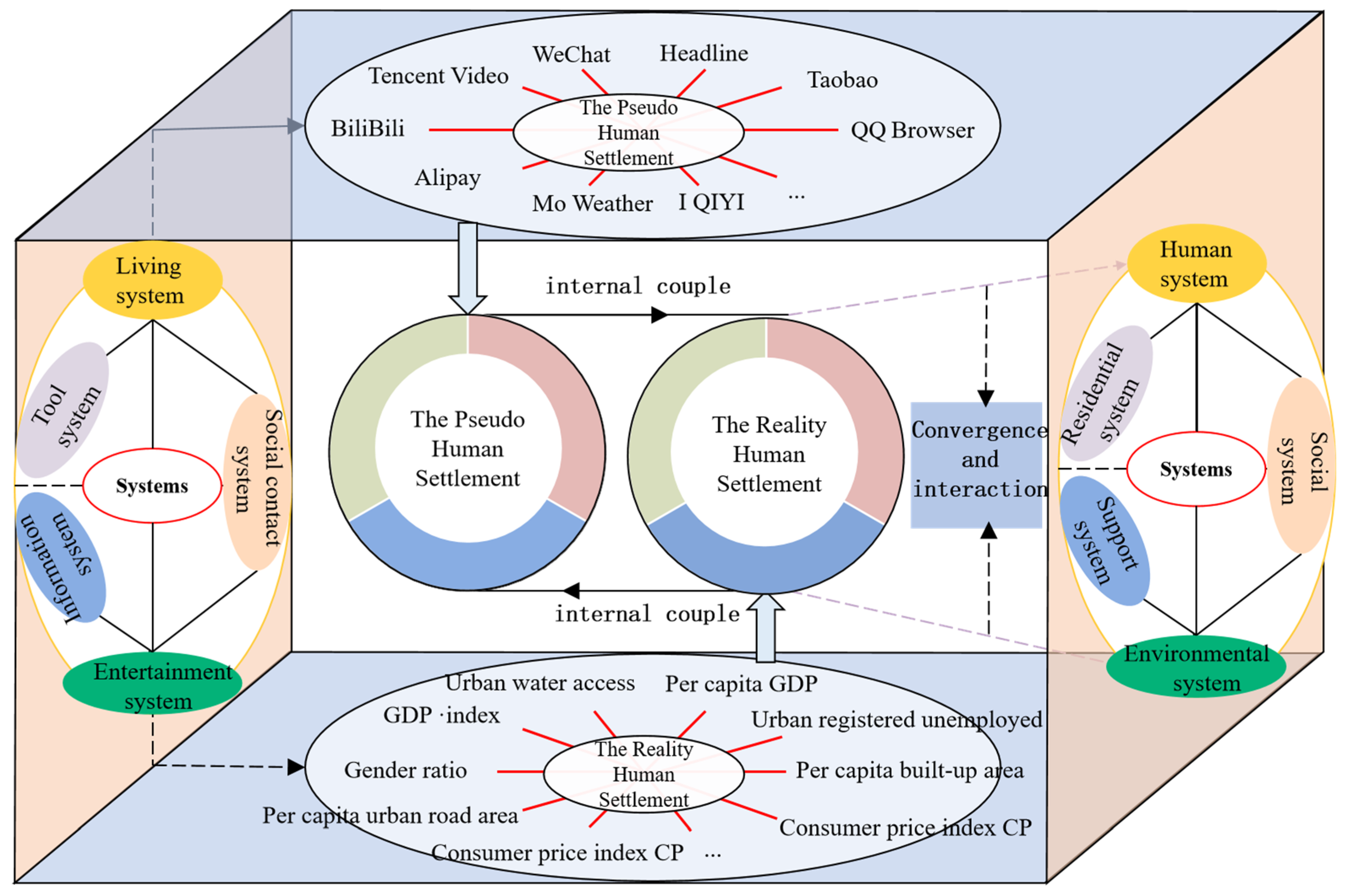
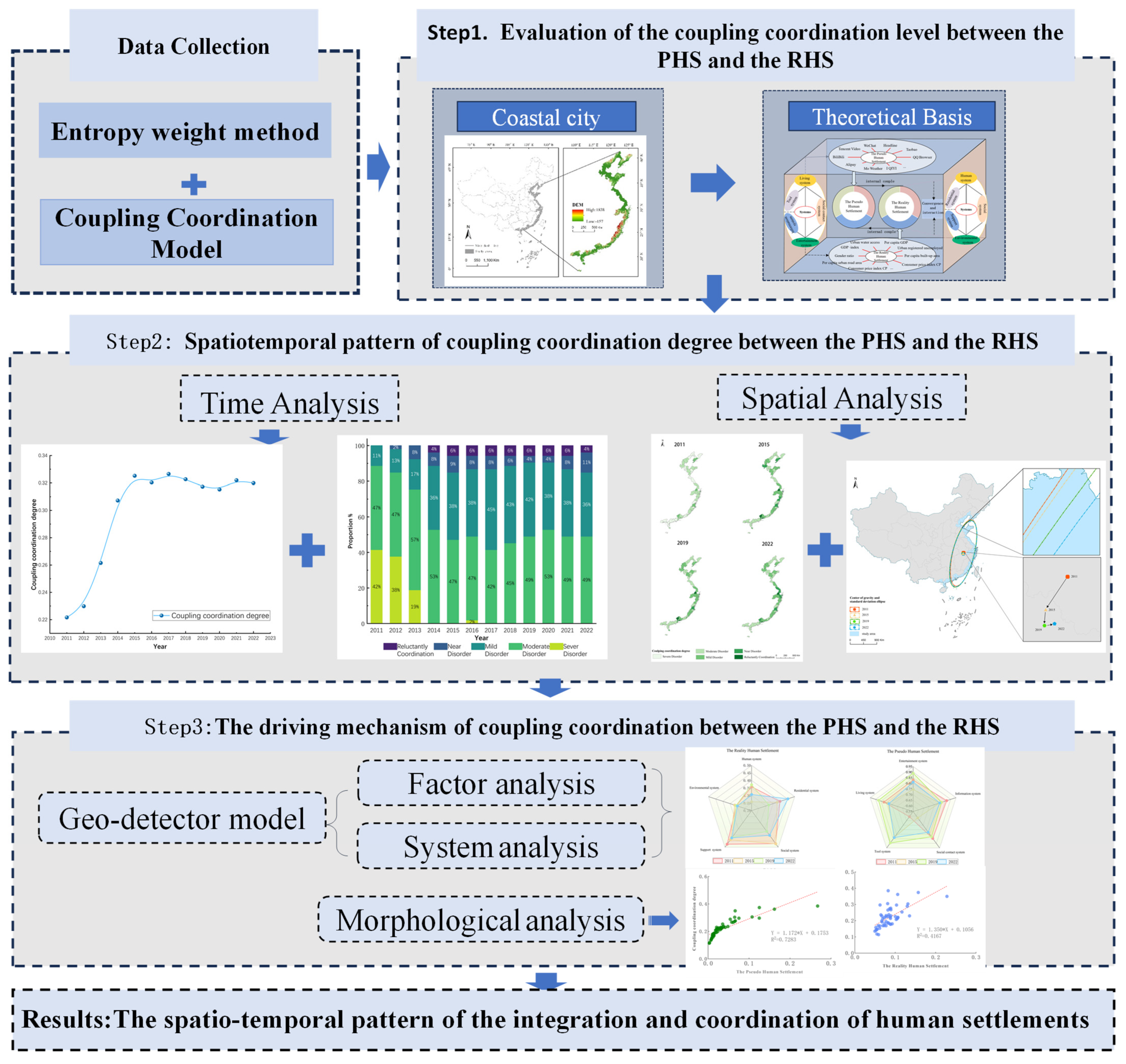

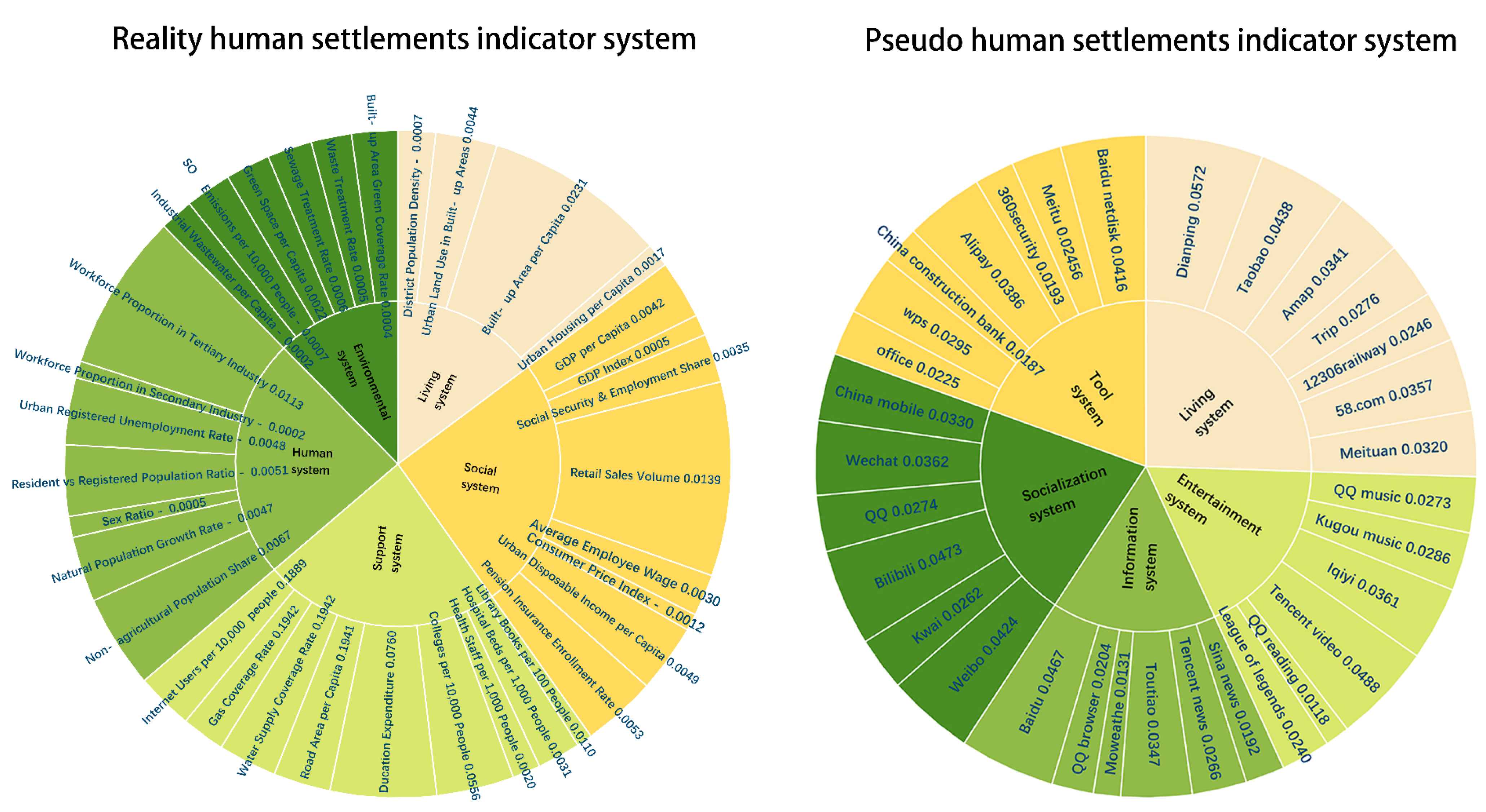
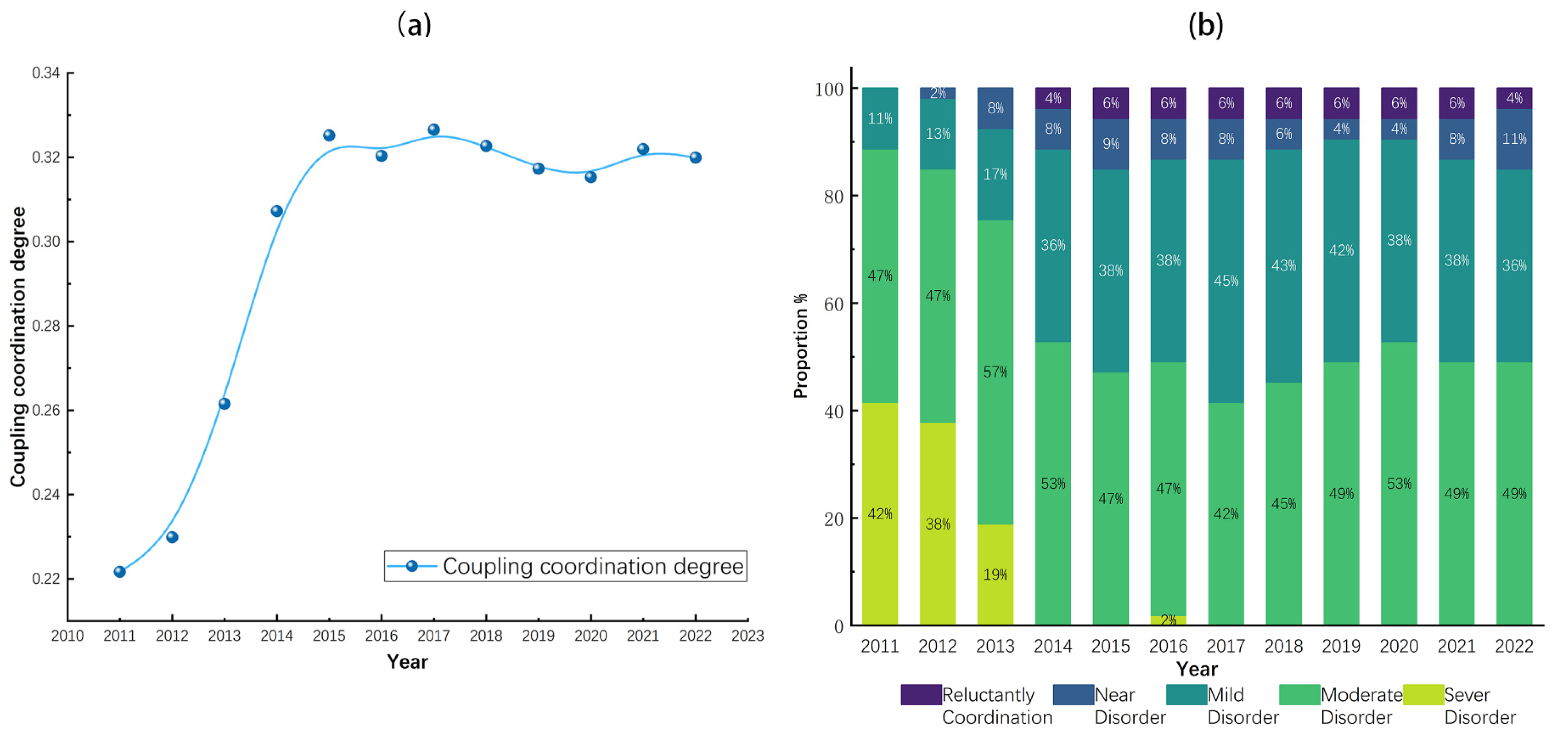


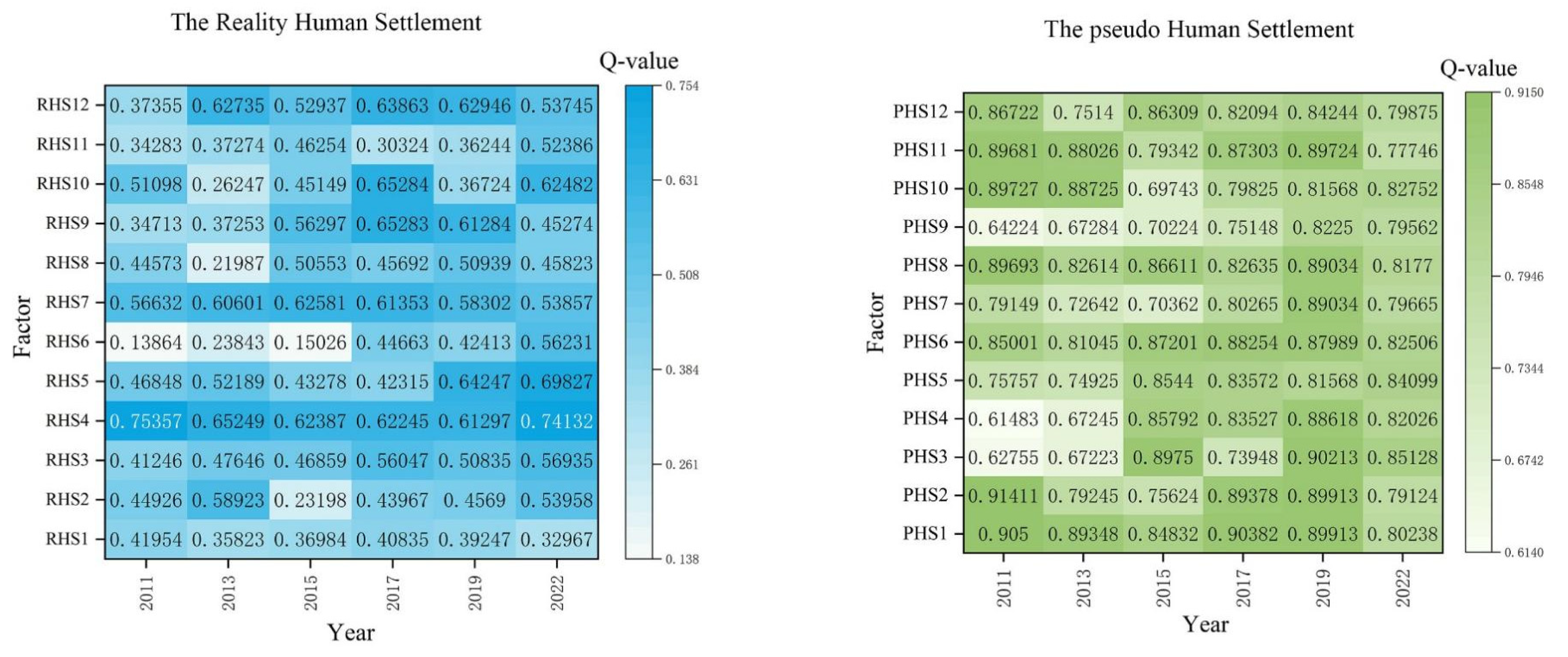
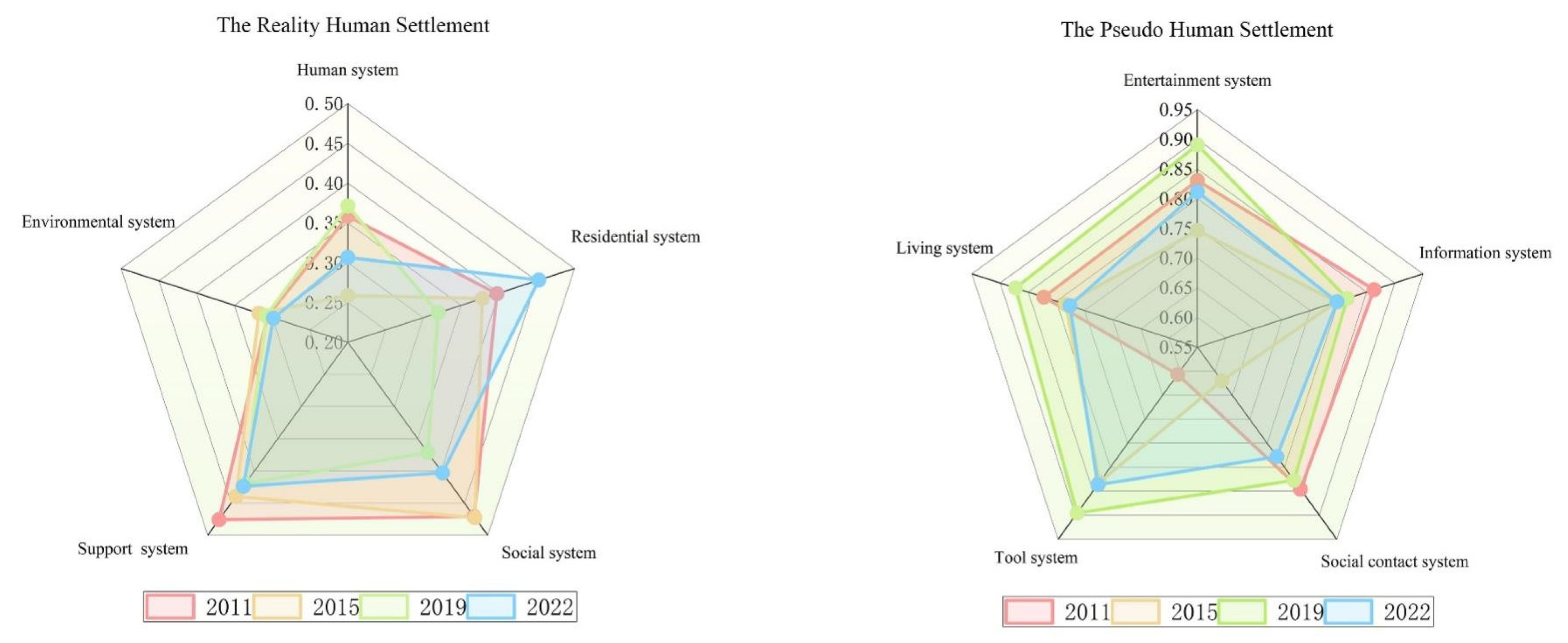
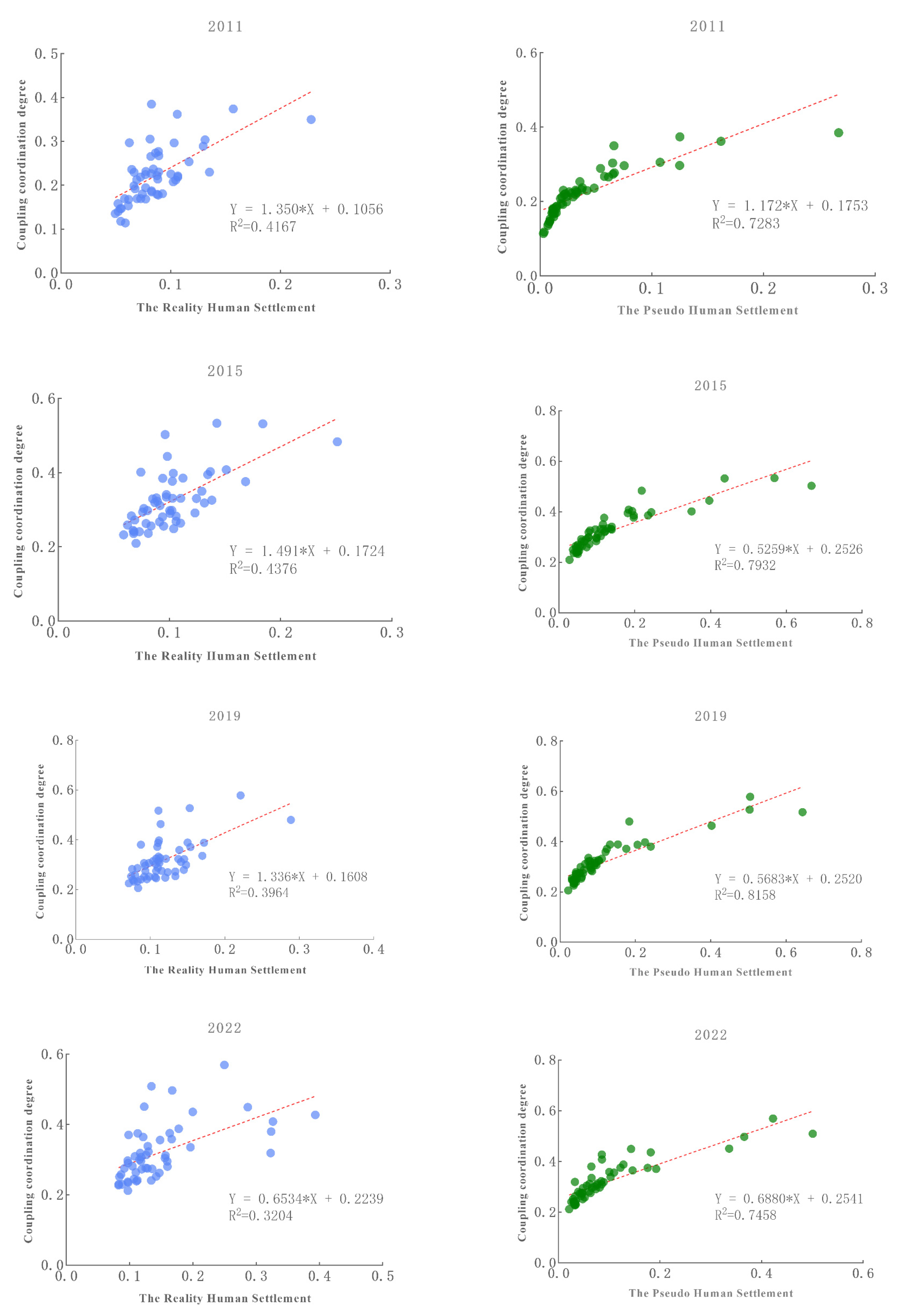
| Coupling Degree | C | Coordination Degree | D | Coupling Degree | C | Coordination Degree | D |
|---|---|---|---|---|---|---|---|
| High-level coupling stage | 0.8 < C ≤ 1 | Excellent Coordination | 0.9 < D ≤ 1.0 | Antagonistic stage | 0.3 < C ≤ 0.5 | Near Disorder | 0.4 < D ≤ 0.5 |
| Good Coordination | 0.8 < D ≤ 0.9 | Mild Disorder | 0.3 < D ≤ 0.4 | ||||
| Break-in stage | 0.5 < C ≤ 0.8 | Intermediate Coordination | 0.7 < D ≤ 0.8 | Low-level coupling stage | 0 < C ≤ 0.3 | Moderate Disorder | 0.2 < D ≤ 0.3 |
| Primary Coordination | 0.6 < D ≤ 0.7 | Severe Disorder | 0.1 < D ≤ 0.2 | ||||
| Reluctantly Coordination | 0.5 < D ≤ 0.6 | Extreme Disorder | 0.0 < D ≤ 0.1 |
Disclaimer/Publisher’s Note: The statements, opinions and data contained in all publications are solely those of the individual author(s) and contributor(s) and not of MDPI and/or the editor(s). MDPI and/or the editor(s) disclaim responsibility for any injury to people or property resulting from any ideas, methods, instructions or products referred to in the content. |
© 2025 by the authors. Licensee MDPI, Basel, Switzerland. This article is an open access article distributed under the terms and conditions of the Creative Commons Attribution (CC BY) license (https://creativecommons.org/licenses/by/4.0/).
Share and Cite
Li, X.; Feng, L.; Du, M.; Tian, S. Spatio-Temporal Coupling Coordination and Driving Mechanism of Urban Pseudo and Reality Human Settlements in the Coastal Cities of China. Land 2025, 14, 2081. https://doi.org/10.3390/land14102081
Li X, Feng L, Du M, Tian S. Spatio-Temporal Coupling Coordination and Driving Mechanism of Urban Pseudo and Reality Human Settlements in the Coastal Cities of China. Land. 2025; 14(10):2081. https://doi.org/10.3390/land14102081
Chicago/Turabian StyleLi, Xueming, Linlin Feng, Meishuo Du, and Shenzhen Tian. 2025. "Spatio-Temporal Coupling Coordination and Driving Mechanism of Urban Pseudo and Reality Human Settlements in the Coastal Cities of China" Land 14, no. 10: 2081. https://doi.org/10.3390/land14102081
APA StyleLi, X., Feng, L., Du, M., & Tian, S. (2025). Spatio-Temporal Coupling Coordination and Driving Mechanism of Urban Pseudo and Reality Human Settlements in the Coastal Cities of China. Land, 14(10), 2081. https://doi.org/10.3390/land14102081





